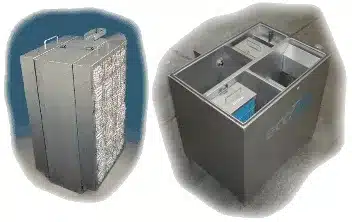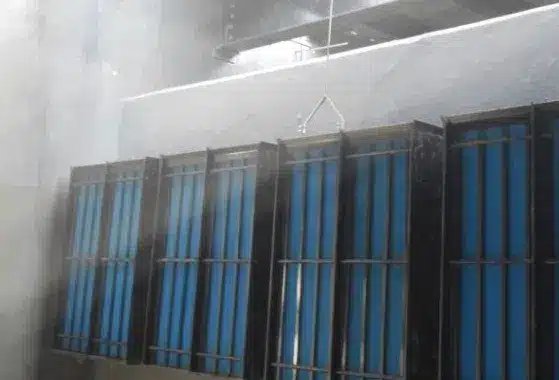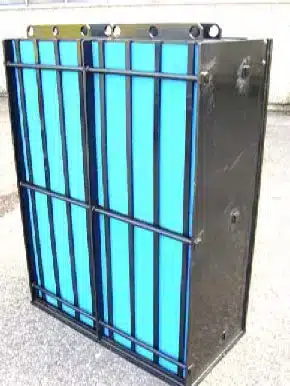In Ontario, a silent guardian works beneath our feet. These Ontario Below Ground Oil Water Separators are key to keeping our environment safe. They stop harmful pollutants from getting into our water.
Freytech Inc. is at the forefront with top-notch separators. Their systems are so efficient, they make water cleaner than ever. They can even remove tiny amounts of emulsified oil, changing the game in wastewater treatment.
With stricter environmental rules, Ontario businesses are turning to these systems. Car washes and big industrial sites need reliable oil water separation more than ever. Are you ready to help make our water cleaner and our future greener?
Key Takeaways
- Ontario Below Ground Oil Water Separators exceed North American discharge limits
- Freytech Inc. offers separators with 5 PPM separation efficiency
- Advanced technology can achieve 0.1 PPM separation for emulsified oil
- Separators effectively remove various hydrocarbons including motor oil and jet fuel
- Underground installation provides discreet and efficient wastewater management
- Compliance with environmental regulations is crucial for businesses in Ontario
Introduction to Below Ground Oil Water Separators
Below Ground Oil Water Separators are key in managing wastewater and protecting the environment. They separate oils and solids from water. This makes them vital for many industries and commercial places.
What are oil water separators?
Oil water separators are devices that take out oil and other contaminants from water. They use gravity to separate lighter oils from heavier water. This way, only clean water goes back into the environment. Below Ground Oil Water Separators are great for handling rainwater runoff and washdowns.
Importance in industrial and commercial settings
In industrial and commercial areas, oil interceptor systems are crucial for following environmental laws. They stop harmful pollutants from getting into water sources. This protects ecosystems and public health. Places like mechanical workshops, gas stations, and parking lots use these systems to handle their wastewater.
Benefits of below ground installation
Choosing below ground installation for oil water separators has many benefits. These systems save space by being put underground. This lets for better use of the surface area. They fit well with existing buildings and help manage stormwater well. Plus, they’re less noticeable, keeping the property looking good while doing their important job.
Ontario Below Ground Oil Water Separators: Specifications and Features
Ontario’s below ground oil water separators are top-notch for treating industrial wastewater. They meet high standards and efficiently separate oil from water.
Certification Standards
These separators follow CAN/ULC-S656 certification in Ontario. This means they are reliable and high-quality in preventing spills. The certification ensures they are safe and work well.
Performance Metrics
These separators are very good at separating oil. They can cut oil levels to less than 5 parts per million (PPM) from 2000 PPM. This is much better than the standard of 15 PPM, making them great for treating industrial wastewater.
Design Elements
Ontario’s separators come in single and double wall types. Both have strong epoxy coatings inside and out for protection. They can handle up to 1000 Imperial gallons per minute, separating certain oils from water.
The design also includes easy-to-remove filter media and a solids collection chamber. This makes them more efficient in managing industrial wastewater.
Applications and Industries Served
Below ground oil water separators are key in many industries. They manage wastewater and keep the environment safe from pollutants. Let’s look at some main areas where these separators are crucial.
Mechanical Workshops and Vehicle Maintenance
In car repair shops, keeping oil-water separators in good shape is important. These places make oily wastewater from cleaning and fixing cars. The separators take out oil and grease before the water goes into the sewer, following environmental laws.
Car Washes and Parking Lots
Car washes need oil water separators to clean up runoff with soap, oil, and dirt. Parking lots also use them to catch pollutants from stormwater before it gets into waterways.
Gas Stations and Oil Depots
Gas stations and places that store oil use separators to deal with spills and leaks. These systems stop groundwater pollution and keep up with laws in areas with lots of petroleum products.
Stormwater Management Solutions
Oil water separators are key in managing stormwater. They clean runoff from roads, industrial areas, and cities, taking out oil and dirt before it gets into the environment. This is vital for keeping waterways clean and safe for living things.
Handling industrial wastewater often means using special separator systems for different kinds of pollutants. From food processing to manufacturing, these separators are made to fit the needs of each industry and protect the environment.
Installation and Maintenance of Below Ground Oil Water Separators
Installing oil-water separators right is key for top performance and following the law. It needs careful planning and sticking to local rules. These systems can sit at ground level or underground, based on the site and needs.
When putting them in, think about the soil, water under the ground, and how easy it is to keep them up. Experts make sure they’re the right size, connect well with other drainage, and follow the law.
Keeping oil-water separators in good shape is vital for their long life and following the law. Cleaning the filter media regularly is important. This can be taken out and used again and again. Checking the solids collection area and cleaning it out when needed keeps the separator working well.
A good maintenance plan includes looking over them every month, cleaning the separation area every three months, and a full check-up every year. This way, separators keep up with discharge rules and environmental standards.
Doing the installation and upkeep right makes oil-water separators last longer and helps the environment. Regular care stops companies from getting big fines and keeps them in good standing with the law.
These separators are crucial in storm water systems. They process runoff to meet the US EPA’s Clean Water Act standards. With effective oily water treatment, facilities protect the environment and dodge big fines.
Conclusion: The Future of Wastewater Management in Ontario
Ontario Below Ground Oil Water Separators are changing how we manage wastewater. They are more efficient at separating, which is key for protecting the environment and following the law. As we focus more on being eco-friendly, these advanced separators are becoming the go-to choice for many industries.
Companies like Freytech Inc. are seeing the value in these high-performance separators. They’re not just for today’s needs; they’re ready for tomorrow’s challenges in wastewater treatment. This forward-thinking is crucial as laws about the environment keep changing.
Looking to the future, Ontario Below Ground Oil Water Separators will be crucial for managing stormwater. They’re great at handling wastewater with oil in it, making them essential for many industries. From car washes to oil depots, these separators are setting new standards for being environmentally friendly.
As Ontario moves towards being greener, these separators are leading the way in sustainable wastewater management. They are a wise choice for businesses wanting to stay ahead of environmental laws. They help make our water cleaner for the future.










